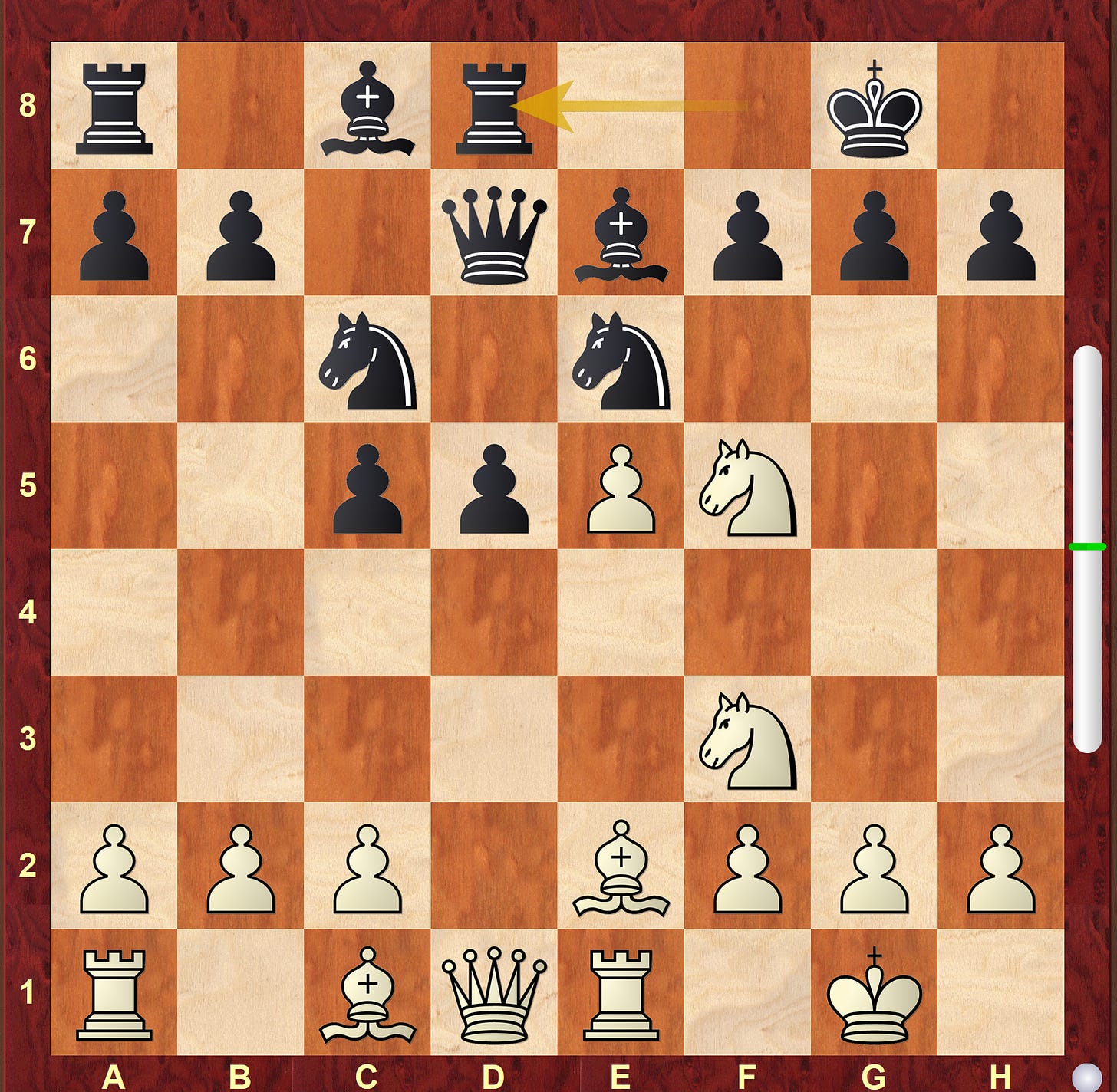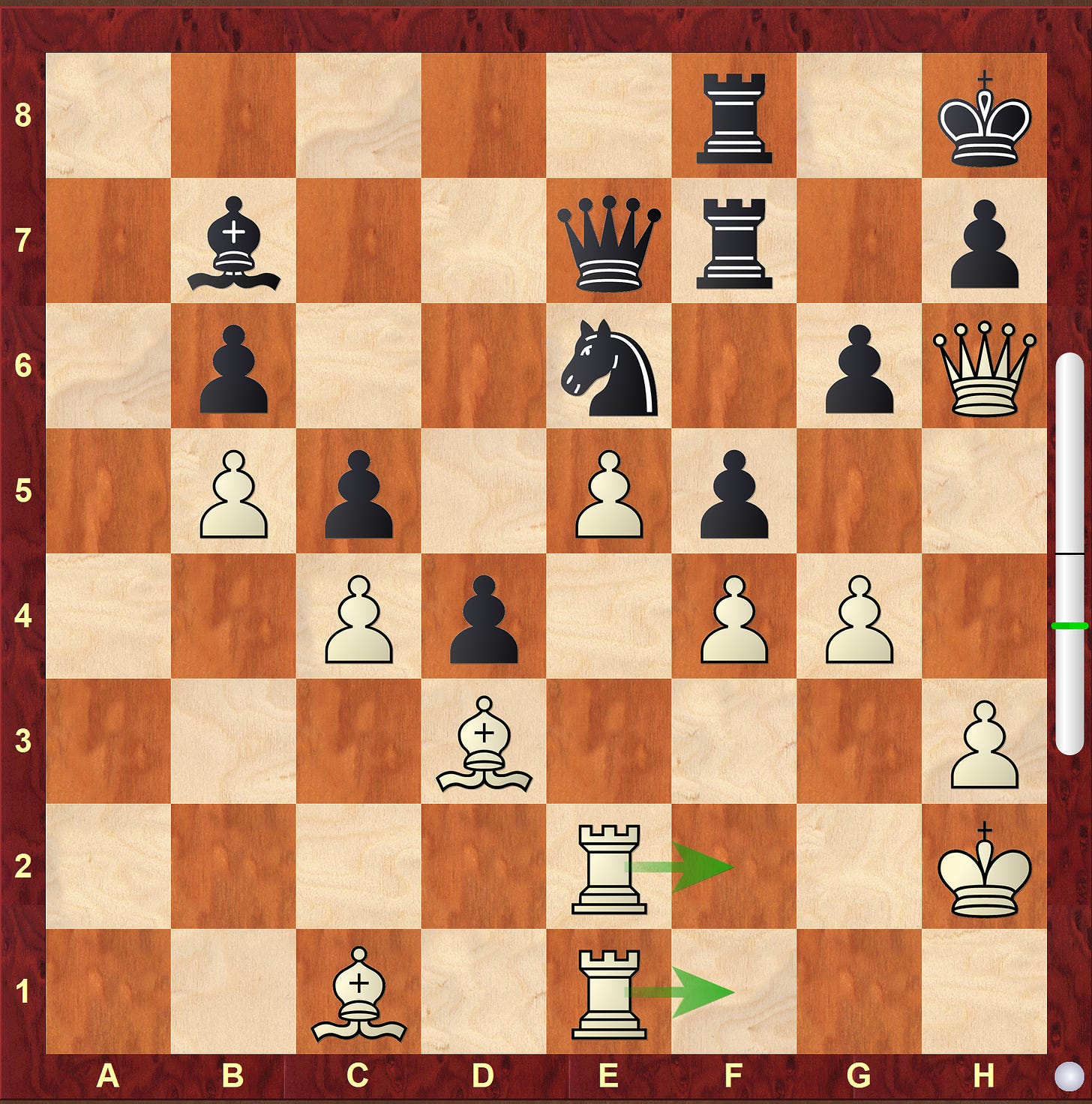This year’s World Cup ended for me with a heartbreaking game. After a great opening preparation, I secured a very promising position which I was not only unable to convert, but I also failed to draw. Eventually, this forced me to play for the win with Black, but I didn’t get any opportunity.
I want to discuss the dramatic first game. While Jules did play well in certain positions, it was mostly my failure.
Below, you can see the game:
FIDE World Cup 2023
White GM Durarbayli, Vasif 2631
Black GM Moussard, Jules 2654
Result 0-1
1. e4 e5 2. Nf3 Nf6 3. d4 Nxe4 4. dxe5 d5 5. Nbd2 Qd7 6. Bd3 Nc5 7. Be2 Ne6 8.
O-O Be7 9. Re1 O-O 10. Nf1 c5 11. Ng3 Nc6

12. Nf5 A different approach to the topical variation from Duda-Nepo Candidates 2022 where game followed: 11.Bd3 Rd8 12.Ng3 g6 13.c3 Nc6 14.h4 with a complicated game Rd8

13. Bf1!?N This move is the first theoretical novelty and conceals an intriguing concept that will soon be revealed. Recently, there were two GM games. A. Muzychuk proceeded with 13.b3 against Koneru in Women’s Candidates 2022. Ergaisi grabbed the bishop on e7 against Fedoseev in Pro Chess League Rapid 2023. Both of these options are playable. Bf8 14. c3 d4?! This is a typical idea and my opponent executed it without much deep consideration. Objectively, it is a good move, but 14… c4! is significantly better, allowing Black to equalize with ease. Nevertheless, it is a challenging move to make because the d4 square appears weak optically.

15.c4! This move took Jules by surprise. The reasoning behind my 13.Bf1 is now clear; this allowed me to sidestep d3 move with a tempo. In this position, d3 is, surprisingly, still the best move! However, while preparing I presumed it impossible to push defended pass pawn forward where it looks like going to be lost but this is actually a viable option with accurate play. This is why I assessed 14…d4?! as a dubious move.
b6 16. a3 Bb7? This is now a serious mistake. 16…d3 was still the best move. Now, Black allows White to block the pawn. From this point onward, Black doesn’t have any counterplay.

17. Bd3! +_ My analysis ended here. White now threatens 18.Ng5 with a crushing attack. Re8! Black stops Ng5. If White plays 18.Ng5? Nxg5 19.Bxg5 Nxe5-+ 18. h3!
This strong move took 16 minutes to find. The initial thought was to play 18.h4?!, employing a typical pawn push, but leaving the h4 square potentially available for the f3 knight was a crucial insight. After 18.h4?!, Black has a powerful h5 move that nearly equalizes the game.
18… Qc7 Jules stops the Nh2 Ng4 maneuver. Now e5 pawn is hanging. 19. b3! Another strong reply. White clears the second rank in order to maneuver the rook to e2 via a2.
18… Nb8? White already enjoys a very pleasant and straightforward strategy. It is not easy to recommend a defense for Black. The engine suggests 18…g6, which weakens the dark squares. However, this move still fails to equalize the game. The idea of Nb8 is to stop the rook lift idea but it allows White to play 19.Nh2!

I immediately wanted to follow my idea. Some may get scared of variation 20.Nh2! Nd7 21. Nhg4 h5. where it appears that Black is set to capture e5 following the knight’s retreat. However, White has a potent sequence starting with 22. Ngh6!! gxh6 23. Qh5! At this point, White has a devastating attack. Black does not have any defense.
If Black grabs e5 23…Nxe5 24.Re5! Qe5 25. Nxh6 Bxh6 26. Qxe5 +- . I saw this idea during the game. However, I don’t have a clear explanation for why I didn’t choose to pursue it. The only explanation I may provide is that 20. Ng5 was looking incredibly tempting, and I might have misevaluated the following position 20.Nh2 Nbd7 21.Ng4 Qc6 22. Be4 Qc7 23. Bd5! +- However, even I could play 23. Bc2!? instead of 23.Bd5 and respond with 24.f3! against Qc6 in the next move. White’s position remains significantly superior. If I hadn’t considered 20. Ng5?, I would undoubtedly have played 20.Nh2!.
20. Ng5? I went for another combination 20…g6?! [ 20…Nd7? 21.Nxf7! Kxf7 22.Qh5+ Kg8 23. Ne7+!! Bxe7 24. Bxh7+ Kf8 25.Bg6 with a Qh8 mate threat. Black needs to give up some material and the end position is losing. Black’s best defense was 20…Nxg5 21.Bxg4 Nd7 22.Bf4 Ne5! entering voluntarily into the pin. The position still looks very dangerous, but the engine gives a tiny bit of an edge to White.

21. Qg4?! I was certain that when I played 20.Ng5?, I would find a mating attack. Had I understood that I was on the wrong path, I would have opted for 20.Nxe6! Rxe6 21.Nh6+ Bxh6 22. Bxh6 Rxe5 23. Qg4! Here, White has great compensation for the pawn. If Black had chosen not to take on e5 and played 22…Nd7 instead, then White could simply respond with f4. The end position looks much like the position in the game, but the bishop is more active. Interestingly, I was willing to sacrifice the e5 pawn in many variations, but I did not spend much time calculating this line here. 21…Nd7 Now again I spent 15 minutes to find a mate but there is none! My pieces look great but cannot do anything. So I played the solid move.

22. f4 Nxg5 23. Qxg5 Kh8?! Black should have started with 23…f6 24. Qg3 then Kh8 the position is around equal. 24. Bd2 Re6 25. Nh6 Bxh6 26. Qxh6 Rae8

This was my last chance to play the most logical move, 27. Re2, and maintain the edge. I wanted to play this in order to defend against the Qc6 idea and also to bring my other rook to the kingside. To be frank, I did not foresee the Be1, Bh4 maneuver at this point. I only came to this realization much later when my opponent did not permit me to do so. So why didn’t I play 27. Re2! ? Suddenly, I started hallucinating. I thought it would somehow allow him to play Nf6 in some positions. To be honest, I can’t provide a logical explanation for what was happening to me. I started to lose the thread of the game completely and started playing one illogical move after another.
27. Qh4?! My idea was to stop the f5 idea. I was initially considering 27.Qg5!?, which was a more logical move because it defends g2 and somewhat neutralizes the f5 threat. At least that was my thinking during the game. However, the engine suggests that f5 is still possible, although it gives White a slight advantage after exf6 27… f5!

The problem is that if White takes on f6, Black has the intermezzo 28…Qc6! This was only possible because I had not positioned my queen on g5. At this point, I should have accepted the fate of the game and understood that I had spoiled the advantageous position. My next move should have been to attempt a draw with 28.exf6. The position is equal after this move. However, this was a difficult realization to accept and I failed to do so. Instead, I was trying to create a breakthrough with g4 and began making moves that I can’t explain. It’s somewhat embarrassing to comment on. As such, I will only use chess annotations to comment until the final blow is delivered.
28. Kh2 Qc6 29. Qg5? R6e7 30. b4?! Qe6 31. Rac1?! (31.a4!) Rf7 32. Re2 Nf8 33. Qh6? Qd7 34. b5?! a6 35.a4? (bxa6!) axb5 36. axb5 Ra8 37. Rce1? (Be1!) Ne6 -+ 38. Bc1 Qe7 39. g4 Raf8

The final mistake comes here. Even though the position was already very bad, some technical work still needed to be done for Black to win. During the game, I was contemplating which rook I should place on the f file. Instead of thinking deeply, I decided to play Rf2 because I thought, “it didn’t matter ”.
40. Rf2?? fxg4! 41. hxg4 Nxf4!

Now, the difference in the rooks’ placements becomes obvious. This is because if White plays 42.Rxf4 Rxf4 43.Bxf4 Rxf4 44. Qxf4 Qh4+, the rook on e1 is left hanging. Additionally, it blocks a square that could have been used by the king, leading to a checkmate for White.
42. e6 Nh5 43. Rxf7 Qh4+ 44. Kg1 Qg3+ 45. Kf1 Qg2# 0-1
For people who prefer video recaps:

Leave a Reply